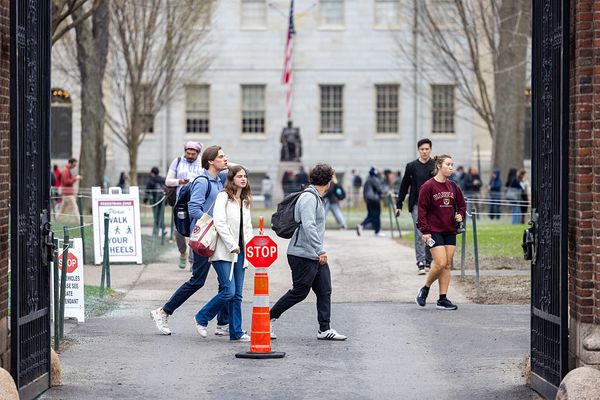
More than two million tuned in to watch a nail-biter the Sunday before last. After BMW’s last-minute drama, a hard-charging Acura prototype nipped after the two leading Penke Porsches until the Rolex 24’s closing moments. In the big sports-car class, a pair of Mustangs podium’d with a chasing Corvette, separating themselves from the screaming Ferraris, roaring 911s, and those rumbling AMGs.
The whole time, the infield buzzed with a party atmosphere. Around midnight, with the Budweiser suds flowing, I watched four Twentysomethings belt out Cotton Eye Joe karaoke to a crowd of absolutely stunned racegoers. After 24 straight hours of racing, the finish came down—literally—to seconds.

This year’s Rolex 24 at Daytona had it all.
I watched the race’s closing hours from the grandstands at Daytona International Speedway, courtesy of an invitation from Rolex, the event’s big sponsor. The Swiss behemoth announced a long-term partnership with IMSA beginning this year, becoming the official timepiece of the series, already inextricably from this event which is known colloquially as "The Rolex 24" in the paddock.
At the end of each edition of "The 24," Rolex hands out its infamous Oyster Cosmograph Daytona watches to the winners of each class, capping the race by awarding motorsport’s ultimate trophy, the race-won watch you see on so many wrists in the paddock.

You’d imagine both Rolex and IMSA were pleased with the weekend; It was great racing—start to finish—whether you were glued to your grandstand or welded to your living room couch.
That’s the secret sauce here. There’s no procession of Formula cars through a bootleg street circuit that have American viewers wondering, "Now why in the hell did I get up at 4:30 AM to watch that?"
Instead, IMSA offers extremely competitive racing with participation from enough automakers that you’ve probably already got a team to root for. In all likelihood, there’s a race car on the grid with the same badge as the one on the car in your driveway. Or at the very least, the one you wish was in your driveway.

That last bit is an undeniably important ingredient in this winning formula. Nine-time Le Mans winner Tom Kristensen, who was on hand as a Rolex ambassador, agreed.
"Now you have a golden era of sports car racing where [the competition is very balanced], but you have a very good visible look, to see 'That's a Lamborghini, that's a Porsche, that's a BMW, that's a Ferrari, that's a Toyota, that's an Alpine.'"
That’s all well and good to draw interest into the sport, but one of the key differentiators with IMSA racing is how they balance performance (called Balance Of Performance, or BOP for short) among the racing classes, which allows for more competitive racing.

By cutting power, adding weight, or otherwise tweaking performance parameters over the course of a season, IMSA can artificially close the gap between the fastest and slowest cars. It’s a controversial subject among teams and drivers, but the result is generally the same as ever: The best teams come out on top.
"But even though the aerodynamics are slightly different, [teams] will get pluses and minuses in terms of weight and in terms of power. So at the end of the day, it's still the best ones winning,
Kristensen said of BOP.
While Kristensen never raced the Daytona 24, the endurance-racing legend notes that if he’d been driving another decade later in his career, he certainly would have had the opportunity to do so. (TK even mentioned that some offers for Daytona had come well after his retirement).

For about the past seven years, America’s IMSA and Europe’s World Endurance Challenge (WEC) have slowly worked toward parity among their various racing classes. That means more manufacturers can race events under similar classing rules across the planet.
So, for example, you’ll now see similar—or identical—vehicles racing at Daytona as the big European endurance classes. This has led to a flood of international talent filling race seats for the Rolex 24, from former F1 winners to Formula E champs to open-wheel standouts.
That competition elevates an already challenging event into must-watch territory, said IMSA race director Mark Raffauf, who I caught up with just outside the sanctioning body’s race-control nerve center.

"So it's like driving from Jacksonville to past Phoenix—almost to Los Angeles—in 24 hours and not screwing up. In this case we started 61 cars, so 60 other crazy people are out there trying to do the same thing," he said. "It's probably one of the most difficult races. I mean compared to Le Mans, the Europeans come over here, this is a much harder race to run in traffic. Everything about it is more difficult."
Hurley Haywood, five-time Daytona 24 winner and yet another legendary Testimonee on hand (that’s Rolex’s insider term for its ambassadors) was also at the event, strolling the Speedway’s grounds like the mayor.
Which he basically is.

Across a pair of interviews, Haywood reiterated the ways in which he was impressed by the modern incarnation of America’s flagship endurance event.
"The pace of the race…" he mused, then paused. "I used to win these races by laps sometimes, and now you've got five or six cars on the lead lap after 24 hours. That's amazing to me that these cars are so strong."
The pole lap for this year’s race, Haywood noted, topped an average speed of 130 mph and can maintain a similar pace in perpetuity, a far cry from the old days when more-fragile machinery spent the race mostly in collision-avoidance mode, letting attrition whittle down the competition.

"Everybody is quite aggressive on the racetrack now and don’t worry about damaging their cars. When Tom [Kristensen] and I raced," Haywood said, "If we had body contact, you are going to have to make a good stop to fix the damage and now that's worse. It doesn't happen anymore. You could be quite aggressive and not do any damage to your car."
The cars, the drivers, and IMSA’s own investment in the future of this race has led to a groundswell in attendance and viewership. IMSA effectively keeps all of its broadcasting logistics in-house, partnering with a few key stakeholders to showcase the sport in a way that will grow the audience in a sustainable, authentic way.

It all amounts to one hell of a spectacle.
Put The Rolex 24 on your calendar for next year, but in the meantime, show up, tune in, and enjoy IMSA racing as often as you can. I promise you won’t regret it, especially if there’s Cotton Eye Joe karaoke.







